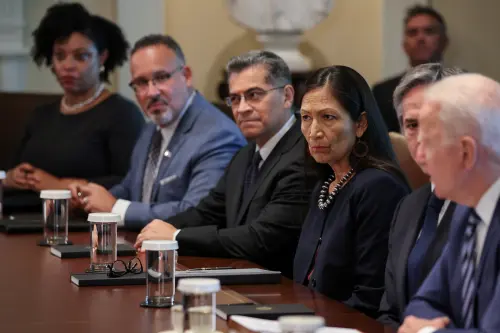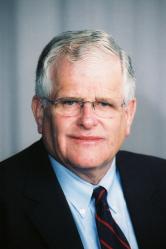Kathryn Dunn Tenpas’s recent FixGov post documented President Biden’s executive branch nominees’ slow confirmation pace at the 200-day mark, but noted that only Richard Nixon had appointed more judges than Biden at that point. The White House has heralded Biden’s “unparalleled speed with respect to judicial nominations.”
By the August recess, the Senate had confirmed nine Biden judicial nominees. Between Feb. 25 and Aug. 8, 1969, the Democratic-led Senate confirmed 10 of Nixon’s lower-court nominees—and seated conservative Chief Justice Warren Burger by a lopsided vote 17 days after his nomination to replace liberal icon Earl Warren.
Nixon’s was a less-partisan confirmation environment. During his tumultuous five-and-a-half-year presidency, the Democratic Senate confirmed over 90% of his lower-court nominees (despite two Supreme Court nomination failures).
Table 1 shows early judicial appointment activity in the more recent era of partisan confirmation battles. Biden’s nine confirmations and 17 confirmation hearings top the list—although George W. Bush and Donald Trump submitted more nominees.
Table 1: Lower court judicial appointment activity prior to first-year August recess
| Biden, 2021 | Date of first nomination | No. of nominations | No. of hearings | No. of confirmations | % of nominees confirmed | |
|---|---|---|---|---|---|---|
| Reagan, 1981 | Unified | July 1 | 12 | 7 | 2 | 17% |
| Bush, 1989 | Divided | Feb. 28 | 8 | 4 | 4 | 50% |
| Clinton, 1993 | Unified | Aug. 6 | 13 | 0 | 0 | 0% |
| Bush, 2001 | Divided | May 9 | 43 | 4 | 3 | 7% |
| Obama, 2009 | Unified | Mar. 17 | 16 | 5 | 0 | 0% |
| Trump, 2017 | Unified | Mar. 21 | 34 | 10* | 4 | 11% |
| Biden, 2021 | Unified | April 19 | 32 | 17 | 9 | 28% |
| * — Includes three Trump nominees who had hearings in 2016 after Obama nominated them in deals with home-state Republican senators. Their 2016 confirmation clock ran out, but Trump renominated them. |
Biden’s aggressive nomination agenda and his nominees’ demographic and professional diversity probably reflect an effort to offset Trump’s near-record number of confirmations and may mollify those pressing him—unsuccessfully—to endorse major changes to the Supreme Court.
What explains his success to date?
First, he may be avoiding time-consuming nomination negotiations with Republican home-state senators. All of Biden’s judicial nominees have been in states with no Republican senators (or no senators at all—for example, Washington, D.C.). Yet, as of early September, of the 59 district vacancies with no nominees, 16 are in states with at least one Republican senator. Of those 16 vacant judgeships, all but one of the incumbents had either left active status by March (creating the vacancy) or announced their intention to do so. The one nominee-less circuit vacancy, which the incumbent announced in February, is in red-state Kansas.
The Trump administration followed somewhat the same pattern. Only one of his 23 pre-recess district nominees was in a state with a Democratic senator. Seven of his 11 circuit nominees were in Democratic-senator states, but Republican Senate leadership closed down efforts by those senators to block circuit nominees. (By contrast, nine of Bush’s 21 pre-recess circuit nominees were in states with Democratic senators, as were eight of his 22 district nominees; for Obama, four of seven circuit and five of nine district nominees were in states with Republican senators.)
Biden, like Trump, has deferred dealing with the Senate’s hoary “blue slip tradition” (explained here and here) under which Senate leadership defers to home-state senators—regardless of party—on whether to process judicial nominees. That obliges the administration to seek nominees acceptable to home-state senators, which often means drawn-out negotiations, especially with opposite-party senators.
For a possible example, one of Idaho’s two judgeships is vacant (and the Judicial Conference says it needs a third judgeship). But local Democratic leaders report White House “radio silence” in response to their March list of possible nominees (all women). Idaho has never had a female district judge, but attempting to fill the vacancy would entail negotiations with the state’s two Republican senators—almost certainly an arduous process.
During the Obama administration, home-state senators enjoyed a virtual veto. Even under Trump, when the Senate apparently afforded home-state senators less deference—and afforded almost no deference as to circuit vacancies—it took longer to submit nominees depending on the make-up of the Senate delegation, as shown in Table 2.
Table 2: Median days between vacancy and nomination, under Trump (2017-2020)*
| Vacancies in states with: | Courts of appeals | District courts |
|---|---|---|
| 2 Republican senators | 108 | 256 |
| Split delegation | 143 | 445 |
| 2 Democratic senators | 238 | 480 |
| * — Excludes vacancies with no Senate delegation (courts of Washington, D.C., Puerto Rico, the Federal Circuit, and International Trade Court). |
Second, Biden has a Senate majority, albeit a razor-thin one. George W. Bush submitted more nominees than any of Table 1’s seven presidents, but Democrats gained control of the Senate on May 24—15 days after Bush’s first wave of nominees. (By contrast, the Democratic Senate confirmed all but two of George H.W. Bush’s first-two-year 73 nominees.)
Finally, unlike four of his recent predecessors, Biden has not had to devote time to filling an early Supreme Court vacancy. (Just ask Justice Breyer’s officious sideline advisers.)
Table 3: Early-term Supreme Court nominations
| Date vacancy announced | Date replacement ____________ Nominated | Date replacement ____________ Confirmed | Days between vacancy and confirmation | |
|---|---|---|---|---|
| 1981 Reagan—O’Connor vice Stewart | June 19 | Aug. 19 | Sept. 21 | 94 |
| 1993 Clinton—Ginsburg vice White | March 20 | June 22 | Aug. 1 | 136 |
| 2009 Obama—Sotomayor vice Souter | May 1 | June 1 | Aug. 6 | 97 |
| 2017 Trump—Gorsuch vice Scalia | Jan. 20* | Feb. 1 | April 7 | 77 |
| * — Inauguration Day 2017. Scalia died in February 2016. |
But it’s not clear how much air Supreme Court vacancies sucked out of the four presidents’ lower-court operations. During the pre-August recess days when the Supreme Court vacancy was active, Reagan submitted 12 lower-court nominees and got two confirmations. Clinton submitted no such nominees prior to the Ginsburg confirmation, but his operation was slow getting started anyway. Obama’s was as well, but he submitted 16 nominations while dealing with the Souter vacancy. Trump submitted only one nomination before the unusually early and unexpected April 7 Gorsuch confirmation.
In short, Biden has outpaced recent predecessors by moving expeditiously on the judicial nominations that are least likely to meet Senate resistance. But he is only in the first inning of his effort to reshape the judiciary. The game may be different once the administration starts dealing with home-state Republican senators—especially if Democrats lose their Senate majority, or a time-consuming Supreme Court vacancy arises.
Data in this post come from mainly from the author’s personal calculations, the Federal Judicial Center’s biographical database, and vacancy data at uscourts.gov. Thanks to Sarah Binder and Kathryn Dunn Tenpas for comments on an earlier draft.
The Brookings Institution is committed to quality, independence, and impact.
We are supported by a diverse array of funders. In line with our values and policies, each Brookings publication represents the sole views of its author(s).







Commentary
Biden is appointing judges faster than Trump, and most everyone else—for now
September 2, 2021